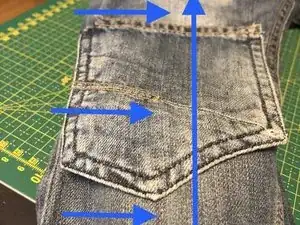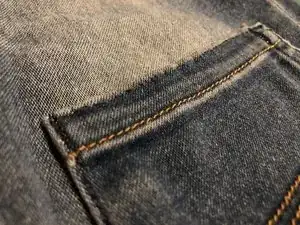Introduction
This guide will show you a way to mend a torn knee of a pair of jeans, by hand, with a patch made from the back pocket of the same jeans. These are a pair of slightly elastic jeans, size 92, but the principle can be applied to almost any kind of trousers.
-
-
For this mend you’ll need a pair of scissors, sewing needle, sewing thread, pins and a seam-ripper(sharp scissors can also work).
-
-
-
Begin by removing the seams of the back pocket that you wish to use as a knee patch. Some pockets have asymmetrical shapes; these have one bottom corner slightly lower than the other, which mirrors the other pocket. If you have a preference, keep that in mind when you choose which pocket goes on which knee.
-
-
-
You can undo the seam in different ways:
-
1) From the front as shown in the photo on the previous step. 2) From between the fabrics, by pulling gently on the pocket seam to reveal the thread underneath. 3) From the inside if the jeans.
-
Choose whichever works best for you. Consider, where is the thread most visible? Where is it easiest to pick up the thread with the ripper or scissors and cut it? Often, alternating is needed.
-
-
-
Try to remove as much of the cut thread as possible to make the patch clean and easy to work with.
-
-
-
Try to find the grain in the fabrics — the lines that indicate the threads of the woven denim — and align the patch and the leg as much as possible. (The altered picture is from another project.)
-
Secure the pocket-patch over the damaged knee area by pinning it in place.
-
-
-
Thread your needle with a ca 70 cm long thread. Tie a knot at the end; often multiple knots on top of each other are needed to stop the thread from escaping through the fabric.
-
If the length of the thread is cumbersome, try to place the needle more toward the middle of the thread so it kind of looks like you’re working with a double thread. As you work and the thread becomes shorter, then you can shift the needle along the length of the thread.
-
However, do NOT leave the extra thread in the actual stitches; you will not easily be able to pull it out again.
-
-
-
Apply the first stitch by pulling the needle through the fabric from the back of the pocket-patch but above the base jeans fabric. This will ensure that the knot will be safe between the fabrics when the stitching is complete, and also ensure that the knot will not disturb the skin of the user afterwards.
-
Keep the stitches close to the edge, ideally along the original seam. The tighter/shorter the stitches, the more stable the mend will be. The easiest stitches would probably be running stitches (just up and down, like a dolphin jumping at the surface of the water), or backstitch (10 mm forward, 5 mm back).
-
-
-
After stitching along the entire edge of the pocket patch, fasten the thread by doing several small stitches in place, and finish by pulling the needle down from the fastening stitches into the space between the fabric layers, creating a long stitch/dive to hide and secure the end of the thread.
-
Lastly, cut the thread along the fabric surface.
-
-
-
Finished: mended knee tear with no-waste patch.
-
If you like, you can do the same to the other knee to match the look.
-












